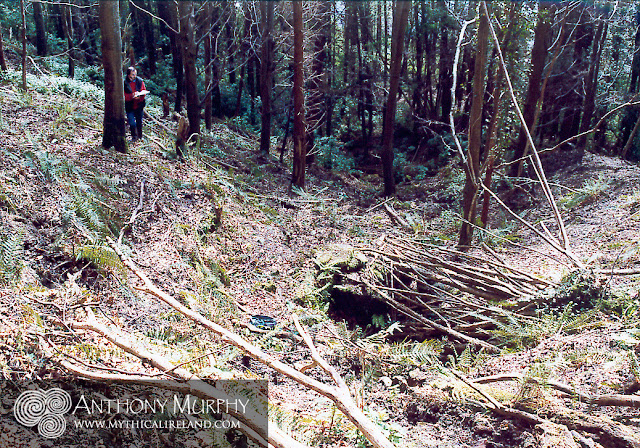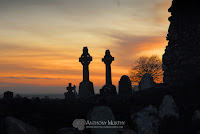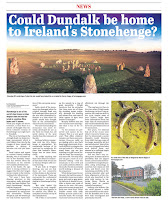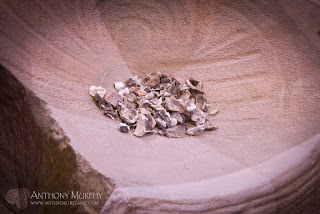I wake up some days and I wonder what we started when we left the forests and turned away from the hunter-gatherer lifestyle towards organised agriculture and monument construction. It was the beginning of modern civilisation, and perhaps the beginning of real conflict between humans. It was a brave but perilous step, emerging from the woods, and clearing land so that we could state in stone and earth something of our cosmology and our spirituality and of our meagre understanding of the great metaphysical mysteries. These questions do not have a time frame. They are relevant today just as much as they were in ancient prehistory:
Who are we?
Where did we come from?
Why are we here?
Where is here?
What is out there?
Why do people die?
What happens to us when we die?
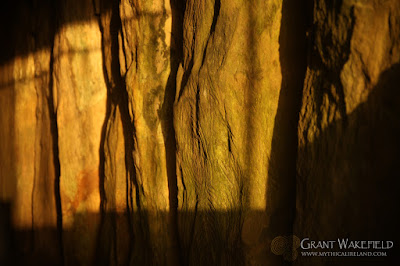 |
| Sunlight enters Knowth's western passage at the autumn equinox. |
I've come to believe that the stone monuments of the Neolithic embody those questions. Their construction was an attempt at understanding - or at least attuning to - some of these mysteries. The mythology of the great monuments of Newgrange and Dowth speaks of the desire to control time on behalf of the gods or kings. If you could measure time, and elucidate some of the complex patterns of the sky, perhaps you could open a vista into deeper mysteries.
There has been a lot of speculation - some of it valid - around the idea of monuments as portals. Do passage-tombs such as Newgrange offer access to hidden realms - realms of consciousness or spirit? Realms of the gods? Detached from the sense world, in the darkness of the interior of Newgrange, do you hallucinate, seeing the geometric shapes that are carved onto the stones of the monument? Trance-like, do you meet the ancestors?
In ancient times, people brought the fragmented remains of their ancestors into these chambers and carefully, lovingly, placed them there in the obvious hope that out of their remains would spring new life - perhaps a life eternal, in other realms. These realms are spoken of in mythology.
In the myths, the gods wage war against each other. There are two battles of Moytura. Eventually, in the second battle, the "good guys", the Tuatha Dé Danann, win out against the "bad guys", the Fomorians. When you witness the magic of the winter solstice light in Newgrange - as I have done - and you see that beam of sunlight piercing the darkness, you begin to realise that that was what the journey of the ancient world was all about. It was about the defeat of darkness by light.
 |
| Winter solstice light in Newgrange. © Paul Kelly. |
But the light of the Tuatha Dé Danann waned when the Milesians came from Spain. The Tuatha Dé Danann went underground, so to speak, agreeing to occupy the
sídhe while the Milesians took sway over Ireland. They weren't defeated as such. They made an accord with the Milesians and vanished into the
sídhe. But this was not their defeat, nor their end. In accessing the
sídhe, those portals to other realms, they were guaranteeing their survival. And the lasting folklore of the Tuatha Dé Danann is that they will return. In fact, some folk prophecy states that they will return for one last great battle, some end-of-the-world scenario, some apocalypse, and that they will be victorious.
So what does all this mean in practical terms, if anything? Were the rumours of a coming return of the Tuatha Dé Danann (and sometimes other great mythical and historical figureheads, such as Fionn Mac Cumhaill or Gearóid Iarla) founded upon the wishes of a repressed and depressed people - an Irish population that had been beaten, downtrodden and starved by centuries of cruel occupation? It is likely that that is part of the tale.
However, there is something about these people of light that makes them endure and endear. They represent our hopes for a better world, those unquenchable hopes that, out of darkness, light will spring. We imagine the return of Lugh Samildánach to Tara, or we envision Aonghus Óg emerging from the great
sídhe of Brugh na Bóinne, to reveal himself once more to the world. We should not lightly discard mythology as mere fairy tale. Joseph Campbell said: “Myth is much more important and true than history.” Myth offers a window into the human spirit, our core nature. We venerate the Tuatha Dé Danann
(1) as manifestations of our light and compassionate aspects, those facets of our being with which we would bring about a peaceful, harmonious and just world, where the very best aspects of humanity would be allowed to flourish. Equally, we acknowledge the presence of the Fomorians, as manifestations of our tyrannous and malevolent aspects, those facets of humanity that would see the world destroyed and allow human suffering to endure. In world myths, the conquest of darkness by light is a recurring theme. This is unsurprising. The myth with light versus darkness at its core is an enduring myth of hope - hope that we will vanquish the dark side of our nature once and for all.
 |
Newgrange before excavation, when the
light could not reach inside. |
Newgrange slept for four millennia - its kerb and entrance concealed by the stones which slipped down off the cairn and sealed it shut. It was "reawakened" in 1699 when the entrance to its passage was rediscovered, and more significantly in the 1960s when it was excavated and its solstice alignment and illumination revealed to the world. Now, hundreds of thousands of people visit the monument every year. The Tuatha Dé Danann are reawakening.
But let us not make the mistake of creating a religion out of the Tuatha Dé Danann. Let us not make them gods or messiahs. Rather, let us make them symbols or metaphors for the reawakening of our own best aspects. In the constant turmoil of a sometimes baffling human existence, where we do the most horrendous things to one another, let us acknowledge that the power to bring about positive change lies entirely within. To create gods of the Tuatha Dé Danann is to engage in a circumvention of our own power, a cop-out in which we declare that the gods have the power, and that they control our destiny.
The truth of the mytho-prescient folk belief in the future return of the Tuatha Dé Danann is that we should not wait at the doorways of the
sídhe for the unlikely emergence of some spectral forms in our desire to prevent a cataclysm. Joseph Campbell also said, in The Power of Myth:
“Heaven and hell are within us, and all the gods are within us. This is the great realization of the Upanishads of India in the ninth Century B.C. All the gods, all the heavens, all the world, are within us. They are magnified dreams, and dreams are manifestations in image form of the energies of the body in conflict with each other. That is what myth is. Myth is a manifestation in symbolic images, in metaphorical images, of the energies of the organs of the body in conflict with each other."
In choosing to allow the Tuatha Dé Danann to manifest within us, we are saying yes to heaven and no to hell. We are inviting the metaphorical image of light to transform into a practical reality, a living embodiment of our own goodness, so that we might prevent the Fomorian forces of darkness from bringing us to the brink of destruction.
 |
Newgrange, with its reconstructed portal, reminds us that the
light can and will return. |
The prophecy of the re-emergence of the Tuatha Dé from the
sídhe should come as no surprise. In a world where darkness often appears to get the upper hand, we need Newgrange to serve as a reminder that the light can and will return - gloriously - and that the darkness is not unending. Imagine that for centuries, and more likely millennia, the winter solstice light was unable to enter Newgrange, because its structural stones had slowly subsided under the weight of the cairn, and the light was cut off. And yet, 5,000 years after it was first constructed, a miracle happened - the light began to shine brilliantly in the cold interior of the monument once again. So too will a miracle happen with the Tuatha Dé Danann. Countless centuries after they retreated to the
sídhe, they will re-emerge. This is a metaphorical miracle - our own good nature must re-emerge, and as a species we must find a way to get along with one another. What other choice do we have? In a world constantly under threat from the forces of darkness, should we just retreat to hidden realms and allow the darkness to abide without challenge?
With Newgrange reconstructed, the portal is now open. It is up to us to call the Tuatha Dé Danann from the
sídhe, to make them manifest within us, to ensure that, as the prophecy states, they will be victorious.
(1) It should be said here that the mythology of the Tuatha Dé Danann is not all filled with goodness. There are battles, and murders, and there is retribution (for example, the Fate of the Sons of Tuireann). However, in a broad sense, the Tuatha Dé Danann are seen as beings of light, and because of the complexity of themes in their story, especially those involving retreat and hibernation for some future awakening, we judge them as the best representation of our hopes for the re-emergence of goodness within us.
(Note: This blog post is a development of some of the themes explored in
this previous post).












